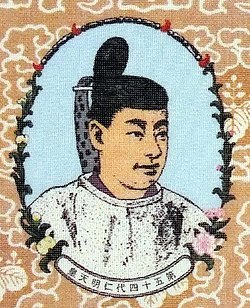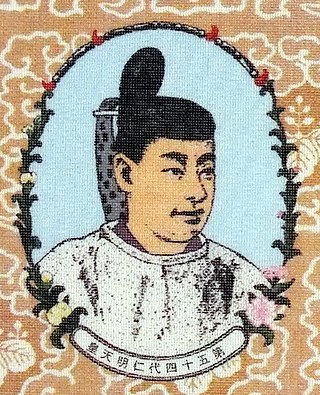Emperor Ninmyō
54th emperor of Japan (r. 833-850) From Wikipedia, the free encyclopedia
Emperor Ninmyō (仁明天皇, Ninmyō-tennō, 27 September 808 – 6 May 850)[1] was the 54th emperor of Japan,[2] according to the traditional order of succession.[3] Ninmyō's reign lasted from 833 to 850, during the Heian period.[4]
| Emperor Ninmyō 仁明天皇 | |||||
|---|---|---|---|---|---|
 | |||||
| Emperor of Japan | |||||
| Reign | 22 March 833 – 4 May 850 | ||||
| Enthronement | 30 March 833 | ||||
| Predecessor | Junna | ||||
| Successor | Montoku | ||||
| Born | Masara (正良) 27 September 808 | ||||
| Died | 6 May 850 (aged 41) Heian Kyō (Kyōto) | ||||
| Burial | Fukakusa no misasagi (深草陵) (Kyoto) | ||||
| Issue more... | |||||
| |||||
| House | Imperial House of Japan | ||||
| Father | Emperor Saga | ||||
| Mother | Tachibana no Kachiko | ||||
Traditional narrative
Summarize
Perspective
Ninmyō was the second son of Emperor Saga and the Empress Tachibana no Kachiko. His personal name (imina) was Masara (正良).[5] After his death, he was given the title Ninmyō (仁明).
Ninmyō had nine Empresses, Imperial consorts, and concubines (kōi); and the emperor had 24 Imperial sons and daughters.[6]
Emperor Ninmyō is traditionally venerated at his tomb; the Imperial Household Agency designates Fukakusa no Misasagi (深草陵, Fukakusa Imperial Mausoleum), in Fushimi-ku, Kyoto, as the location of Ninmyō's mausoleum.[2]
Events of Ninmyō's life

Ninmyō ascended to the throne following the abdication of his uncle, Emperor Junna.
- 6 January 823[7] (Kōnin 10, 4th month, 19th day[8]): Received the title of Crown Prince at the age of 14.
- 22 March 833 (Tenchō 10, 28th day of the 2nd month[9]): In the 10th year of Emperor Junna's reign, the emperor abdicated; and the succession (senso) was received by his adopted son. Masara-shinnō was the natural son of Emperor Saga, and therefore would have been Junna's nephew.[6] Shortly thereafter, Emperor Ninmyo is said to have acceded to the throne (sokui).[10]
Shortly after Ninmyo was enthroned, he designated an heir. He named Prince Tsunesada, a son of former Emperor Junna, as the crown prince.[11]
- 835 (Jōwa 2[12]): Kūkai (known posthumously as Kōbō-Daishi) died. This monk, scholar, poet, and artist had been the founder of the Shingon or "True Word" school of Buddhism.[11]
- 838-839 (Jōwa 5-6): Diplomatic mission to Tang China headed by Fujiwara no Tsunetsugu.[13]
- 842: Following a coup d'état called the Jōwa Incident, Tsunesada the crown prince was replaced with Ninmyō's first son, Prince Michiyasu (later Emperor Montoku) whose mother was the Empress Fujiwara no Junshi, a daughter of sadaijin Fujiwara no Fuyutsugu. It is supposed that this was the result of political intrigue planned by Ninmyō and Fujiwara no Yoshifusa.[14] The first of what would become a powerful line of Fujiwara regents,[15] Yoshifusa had numerous family ties to the imperial court; he was Ninmyō's brother in law (by virtue of his sister who became Ninmyō's consort), the second son of sadaijin Fuyutsugu, and uncle to the new crown prince.[14]
In his lifetime, Ninmyō could not have anticipated that his third son, Prince Tokiyasu, would eventually ascend the throne in 884 as Emperor Kōkō.[16]
Eras of Ninmyō's reign
The years of Ninmyō's reign are more specifically identified by more than one era name (nengō).[21]
Kugyō
Kugyō (公卿) is a collective term for the very few most powerful men attached to the court of the Emperor of Japan in pre-Meiji eras.[22]
In general, this elite group included only three to four men at a time. These were hereditary courtiers whose experience and background would have brought them to the pinnacle of a life's career. During Ninmyō's reign, this apex of the Daijō-kan included:
- Sadaijin, Fujiwara no Otsugu (藤原緒嗣), 773–843.[23]
- Sadaijin, Minamoto no Tokiwa (源常), 812–854.[6]
- Udaijin, Kiyohara no Natsuno (清原夏野), 782–837.[6]
- Udaijin, Fujiwara no Mimori (藤原三守), d. 840.[6]
- Udaijin, Minamoto no Tokiwa (源常)
- Udaijin, Tachibana no Ujikimi (橘氏公), 783–847.[6]
- Udaijin, Fujiwara no Yoshifusa (藤原良房), 804–872.[11]
- Udaijin, Fujiwara no Otsugu, 825–832[23]
- Naidaijin (not appointed)
- Dainagon, Fujiwara no Otsugu, ?–825.[24]
Consorts and children
Summarize
Perspective
Consort (Nyōgo) later Empress Dowager (Tai-Kōtaigō): Fujiwara no Junshi (藤原順子; 809–871), Fujiwara no Fuyutsugu’s daughter
- First Son: Imperial Prince Michiyasu (道康親王) later Emperor Montoku
Consort (Nyōgo): Fujiwara no Takushi/Sawako (藤原沢子; d.839), Fujiwara no Fusatsugu’s daughter
- Second Son: Imperial Prince Muneyasu (宗康親王; 828–868)
- Third Son: Imperial Prince Tokiyasu (時康親王) later Emperor Kōkō
- Fourth Son: Imperial Prince Saneyasu (人康親王; 831–872)
- Imperial Princess Shinshi (新子内親王; d.897)
Consort (Nyōgo): Fujiwara no Teishi/Sadako (藤原貞子; d.864), Fujiwara no Tadamori’s daughter
- Eighth Son: Imperial Prince Nariyasu (成康親王; 836–853)
- Imperial Princess Shinshi (親子内親王; d. 851)
- Imperial Princess Heishi (平子内親王; d. 877)
Court lady: Shigeno no Tsunako (滋野縄子), Shigeno no Sadanushi’s daughter
- fifth Son: Imperial Prince Motoyasu (本康親王; d. 902)
- Ninth Daughter: Imperial Princess Tokiko (時子内親王; d. 847), 2nd Saiin in Kamo Shrine 831–833
- Imperial Princess Jūshi (柔子内親王; d. 869)
Consort (Nyōgo): Tachibana no Kageko (橘影子; d. 864), Tachibana no Ujikimi’s daughter
Consort (Nyōgo): Fujiwara Musuko (藤原息子)
Court Attendant (Koui): Ki no Taneko (紀種子; d. 869), Ki no Natora’s daughter
- Seventh Prince: Imperial Prince Tsuneyasu (常康親王; d. 869)
- Imperial Princess Shinshi/Saneko (真子内親王; d. 870)
Court Attendant (Koui) (deposed in 845): Mikuni-machi (三国町), daughter of Mikuni clan
- Sada no Noboru (貞登), given the family name "Sada" from Emperor (Shisei Kōka, 賜姓降下) in 866
Court lady: Fujiwara no Katoko (藤原賀登子), Fujiwara no Fukutomaro's daughter
- Sixth Son: Imperial Prince Kuniyasu (国康親王; d. 898)
Court lady: Fujiwara no Warawako (藤原小童子), Fujiwara no Michitō's daughter
- Imperial Princess Shigeko (重子内親王; d. 865)
Court lady: Princess Takamune (高宗女王), Prince Okaya's daughter
- Seventh/eighth Daughter: Imperial Princess Hisako (久子内親王; d. 876), 18th Saiō in Ise Shrine 833–850.[25]
Court lady: daughter of Yamaguchi clan (山口氏の娘)
- Minamoto no Satoru (源覚; 849–879)
Nyoju: Kudaraō Toyofuku's daughter
- Minamoto no Masaru (源多; 831–888), Udaijin 882–888
- Minamoto no Hikaru (源光; 846–913), Udaijin 901–913
Court lady (Nyoju): Kudara no Yōkyō (百済永慶), Kudara no Kyōfuku's daughter
- Twelfth Daughter: Imperial Princess Takaiko (高子内親王; d. 866), 3rd Saiin in Kamo Shrine 833–850
(from unknown women)
- Minamoto no Suzushi (源冷; 835–890), Sangi 882–890
- Minamoto no Itaru (源効)
Ancestry
| Ancestors of Emperor Ninmyō | |||||||||||||||||||||||||||||||||||||||||||||||||||||||||||||||||||||||||||||||||||||||||||||||||||||||||||||||||||||||||||||||||||||||||||||||||||||||||||||||||||||||||||||||||||||||||||||||||||||||||||||||||||||||||||||||||||||||||||||||||||||||||||||||||||||||||
|---|---|---|---|---|---|---|---|---|---|---|---|---|---|---|---|---|---|---|---|---|---|---|---|---|---|---|---|---|---|---|---|---|---|---|---|---|---|---|---|---|---|---|---|---|---|---|---|---|---|---|---|---|---|---|---|---|---|---|---|---|---|---|---|---|---|---|---|---|---|---|---|---|---|---|---|---|---|---|---|---|---|---|---|---|---|---|---|---|---|---|---|---|---|---|---|---|---|---|---|---|---|---|---|---|---|---|---|---|---|---|---|---|---|---|---|---|---|---|---|---|---|---|---|---|---|---|---|---|---|---|---|---|---|---|---|---|---|---|---|---|---|---|---|---|---|---|---|---|---|---|---|---|---|---|---|---|---|---|---|---|---|---|---|---|---|---|---|---|---|---|---|---|---|---|---|---|---|---|---|---|---|---|---|---|---|---|---|---|---|---|---|---|---|---|---|---|---|---|---|---|---|---|---|---|---|---|---|---|---|---|---|---|---|---|---|---|---|---|---|---|---|---|---|---|---|---|---|---|---|---|---|---|---|---|---|---|---|---|---|---|---|---|---|---|---|---|---|---|---|---|---|---|---|---|---|---|---|---|---|---|---|---|---|---|---|
| |||||||||||||||||||||||||||||||||||||||||||||||||||||||||||||||||||||||||||||||||||||||||||||||||||||||||||||||||||||||||||||||||||||||||||||||||||||||||||||||||||||||||||||||||||||||||||||||||||||||||||||||||||||||||||||||||||||||||||||||||||||||||||||||||||||||||
See also
- Emperor Go-Fukakusa, a later emperor named in honor of Emperor Ninmyō
- Imperial cult
- List of Emperors of Japan
- Shoku Nihon Kōki, a Japanese national history covering Emperor Ninmyō's reign.
Notes
References
External links
Wikiwand - on
Seamless Wikipedia browsing. On steroids.
